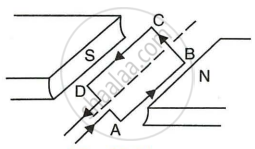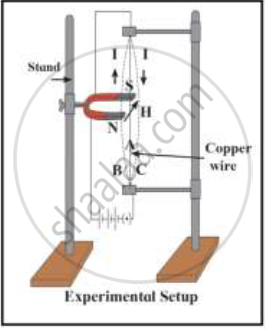Advertisements
Advertisements
Question
A current-carrying straight wire is held in exactly vertical position. If the current passes through this wire in the vertically upward direction, what is the direction of magnetic field produced by it? Name the rule used to find the direction of magnetic field.
Solution
It is given that the current-carrying straight wire is held in vertical position. If current passes through this wire in vertically upward direction, magnetic field produced by it will be in anticlockwise direction. Right hand thumb rule will be used to find the direction of magnetic field.
APPEARS IN
RELATED QUESTIONS
Draw a sketch to show the magnetic lines of force due to a current-carrying straight conductor.
A soft iron bar is inserted inside a current-carrying solenoid. The magnetic field inside the solenoid:
(a) will decrease
(b) will increase
(c) will become zero
(d) will remain the same
A current-carrying conductor is held in exactly vertical direction. In order to produce a clockwise magnetic field around the conductor, the current should passed in the conductor:
(a) from top towards bottom
(b) from left towards right
(c) from bottom towards top
(d) from right towards left
When is the force experienced by a current-carrying conductor placed in a magnetic field largest?
A current-carrying conductor is placed perpendicularly in a magnetic field. Name the rule which can be used to find the direction of force acting on the conductor.
A coil ABCD mounted on an axle is placed between the poles N and S of a permanent magnet as shown in Figure.

- In which direction will the coil begin to rotate when current is passed through the coil in direction ABCD by connecting a battery at the ends A and D of the coil?
- Why is a commutator necessary for continuous rotation of the coil?
- Complete the diagram with commutator, etc. for the flow of current in the coil?
i) Which principle is explained in this figure?
ii) Which rule is used to find out the direction of a force in this principle?
iii) In which machine this principle is used? Draw a diagram showing working of that machine

For a current in a long straight solenoid N- and S-poles are created at the two ends. Among the following statements, the incorrect statement is
Describe the activity that shows that a current-carrying conductor experiences a force perpendicular to its length and the external magnetic field. How does Fleming’s left-hand rule help us to find the direction of the force acting on the current carrying conductor?
Which of the following pattern correctly describes the magnetic field around a long straight wire carrying current?
